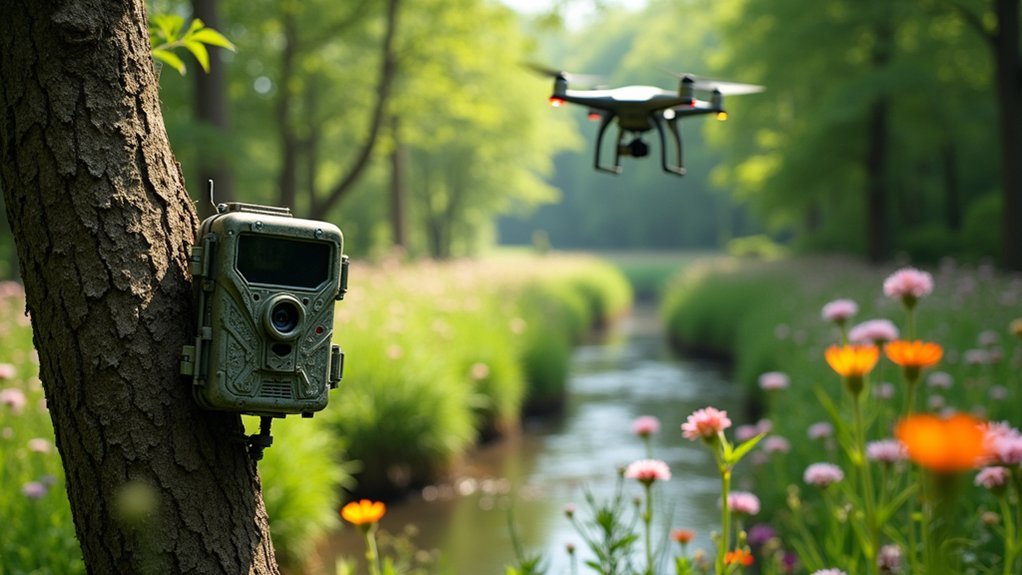You’ll get the most thorough wildlife sanctuary monitoring using three proven methods: camera traps positioned along natural movement corridors for 24/7 documentation without disturbance, citizen science networks that leverage local knowledge through mobile apps, and remote acoustic sensors that capture vocalizations to identify elusive species. These technologies work together to minimize human interference while maximizing data collection. The following insights will transform how you approach wildlife observation in protected areas.
Camera Trap Deployment for Urban Avian Documentation

While traditional bird-watching requires patience and timing, camera traps have revolutionized urban avian monitoring by continuously collecting data without human presence.
You’ll capture natural behaviors that would otherwise be disrupted by human observers.
For ideal results, position your camera traps at heights and angles that align with typical flight paths and perches.
Strategic camera placement along natural flight paths delivers optimal monitoring results with minimal disturbance.
This strategic placement maximizes detection rates in urban environments where habitat loss threatens avian populations.
The infrared technology in these devices enables 24/7 monitoring, documenting both day and night activity patterns without disturbing the birds.
This extensive data collection reveals valuable insights about species diversity and behavior, contributing considerably to conservation efforts.
Citizen Science Monitoring Networks for Rare Species Tracking
Beyond technological solutions like camera traps, the power of human observation networks creates an unparalleled monitoring system for rare species.
Citizen science initiatives greatly expand your data collection capabilities while fostering community involvement in biodiversity protection.
You’ll find that local volunteers often possess intimate knowledge of habitats, markedly improving detection rates for elusive species.
By leveraging mobile apps and online platforms, you’re enabling efficient reporting that extends the geographical reach of your monitoring efforts.
The collaboration between researchers and citizen scientists ensures accuracy and reliability in the collected data.
These partnerships have documented previously unknown populations and inform critical conservation efforts.
When properly implemented, these networks transform ordinary community members into valuable conservation allies, creating a sustainable approach to tracking and protecting rare species.
Remote Acoustic Sensors for Detecting Elusive City Birds

How can you effectively monitor urban birds that evade traditional observation methods? Remote acoustic sensors, particularly Acoustic Recording Units (ARUs), provide an innovative solution.
These devices continuously capture bird vocalizations, revealing species presence that might otherwise go undetected in busy urban environments. Unlike conventional wildlife monitoring approaches, acoustic sensors offer broader detection coverage and reduce observer bias when tracking elusive birds.
You’ll collect higher quality data on temporal vocalization patterns, helping identify peak activity periods in city sanctuaries. The sensors excel at monitoring cryptic species in dense urban settings where visual observation proves challenging.
For extensive conservation efforts, combine acoustic monitoring with other methods to better understand bird populations’ responses to habitat changes. This integrated approach delivers valuable insights into how urban birds adapt to city life.
Frequently Asked Questions
What Are the Methods Used to Monitor Wildlife Populations?
You can monitor wildlife populations using camera traps, acoustic recording units, GPS tracking collars, environmental DNA analysis, and occupancy modeling. Each method captures different data without human disturbance.
What Are Some Other Methods for Tracking Wildlife?
You can track wildlife through radio telemetry, hair snares, scat analysis, thermal imaging, footprint tracking, isotope analysis, bioacoustics, citizen science apps, trail counters, and microchip implants for detailed behavior monitoring.
What Is an Effective Wildlife Management Tool?
An effective wildlife management tool is camera trapping. You’ll find it captures wildlife behavior without human presence. It’s continuous, non-invasive, and gives you valuable data on species’ activities and population dynamics.
Which of the Following Is the Most Effective Method of Wildlife Conservation?
The most effective method of wildlife conservation is integrating multiple approaches. You’ll find combining camera traps, PAM, occupancy modeling, and satellite imagery gives you thorough data to make informed decisions while minimizing disturbance to wildlife.
In Summary
You’ve now explored three powerful wildlife monitoring methods for urban sanctuaries. By strategically placing camera traps, you’ll capture visual evidence of avian visitors. When you engage citizen scientists, you’re expanding your data collection capacity for rare species. And don’t forget acoustic sensors—they’ll help you detect birds you’d otherwise miss. Combining these approaches, you’ll develop a thorough understanding of your sanctuary’s ecological health and biodiversity.





Leave a Reply